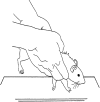Forced limb-use effects on the behavioral and neurochemical effects of 6-hydroxydopamine
- PMID: 11404429
- PMCID: PMC6762734
- DOI: 10.1523/JNEUROSCI.21-12-04427.2001
Forced limb-use effects on the behavioral and neurochemical effects of 6-hydroxydopamine
Abstract
Rats with unilateral depletion of striatal dopamine (DA) show marked preferential use of the ipsilateral forelimb. Previous studies have shown that implementation of motor therapy after stroke improves functional outcome (Taub et al., 1999). Thus, we have examined the impact of forced use of the impaired forelimb during or soon after unilateral exposure to the DA neurotoxin 6-hydroxydopamine (6-OHDA). In one group of animals, the nonimpaired forelimb was immobilized using a cast, which forced exclusive use of the impaired limb for the first 7 d after infusion. The animals that received a cast displayed no detectable impairment or asymmetry of limb use, could use the contralateral (impaired) forelimb independently for vertical and lateral weight shifting, and showed no contralateral turning to apomorphine. The behavioral effects were maintained throughout the 60 d of observation. In addition to the behavioral sparing, these animals showed remarkable sparing of striatal DA, its metabolites, and the expression of the vesicular monoamine transporter, suggesting a decrease in the extent of DA neuron degeneration. Behavioral and neurochemical sparing appeared to be complete when the 7 d period of immobilization was initiated immediately after 6-OHDA infusion, only partial sparing was evident when immobilization was initiated 3 d postoperatively, and no sparing was detected when immobilization was initiated 7 d after 6-OHDA treatment. These results suggest that physical therapy may be beneficial in Parkinson's disease.
Figures








Similar articles
-
Neuroprotective effects of prior limb use in 6-hydroxydopamine-treated rats: possible role of GDNF.J Neurochem. 2003 Apr;85(2):299-305. doi: 10.1046/j.1471-4159.2003.01657.x. J Neurochem. 2003. PMID: 12675906
-
Forced nonuse in unilateral parkinsonian rats exacerbates injury.J Neurosci. 2002 Aug 1;22(15):6790-9. doi: 10.1523/JNEUROSCI.22-15-06790.2002. J Neurosci. 2002. PMID: 12151559 Free PMC article.
-
Exercise induces behavioral recovery and attenuates neurochemical deficits in rodent models of Parkinson's disease.Neuroscience. 2003;119(3):899-911. doi: 10.1016/s0306-4522(03)00096-4. Neuroscience. 2003. PMID: 12809709
-
Compensatory responses to nigrostriatal bundle injury. Studies with 6-hydroxydopamine in an animal model of parkinsonism.Mol Chem Neuropathol. 1989 Jun;10(3):185-200. doi: 10.1007/BF03159728. Mol Chem Neuropathol. 1989. PMID: 2504173 Review.
-
The unilateral 6-hydroxydopamine lesion model in behavioral brain research. Analysis of functional deficits, recovery and treatments.Prog Neurobiol. 1996 Oct;50(2-3):275-331. doi: 10.1016/s0301-0082(96)00040-8. Prog Neurobiol. 1996. PMID: 8971983 Review.
Cited by
-
LSVT LOUD and LSVT BIG: Behavioral Treatment Programs for Speech and Body Movement in Parkinson Disease.Parkinsons Dis. 2012;2012:391946. doi: 10.1155/2012/391946. Epub 2012 Mar 15. Parkinsons Dis. 2012. PMID: 22530161 Free PMC article.
-
Early and progressive sensorimotor anomalies in mice overexpressing wild-type human alpha-synuclein.J Neurosci. 2004 Oct 20;24(42):9434-40. doi: 10.1523/JNEUROSCI.3080-04.2004. J Neurosci. 2004. PMID: 15496679 Free PMC article.
-
Ingestion of subthreshold doses of environmental toxins induces ascending Parkinsonism in the rat.NPJ Parkinsons Dis. 2018 Sep 27;4:30. doi: 10.1038/s41531-018-0066-0. eCollection 2018. NPJ Parkinsons Dis. 2018. PMID: 30302391 Free PMC article.
-
Blueberry juice augments exercise-induced neuroprotection in a Parkinson's disease model through modulation of GDNF levels.IBRO Neurosci Rep. 2022 Mar 7;12:217-227. doi: 10.1016/j.ibneur.2022.03.001. eCollection 2022 Jun. IBRO Neurosci Rep. 2022. PMID: 35321527 Free PMC article.
-
How might physical activity benefit patients with Parkinson disease?Nat Rev Neurol. 2011 Jul 12;7(9):528-34. doi: 10.1038/nrneurol.2011.107. Nat Rev Neurol. 2011. PMID: 21750523 Review.
References
-
- Bilowit DS. Establishing physical objectives in rehabilitation of patients with Parkinson's disease (gymnasium activities). Phys Ther Rev. 1956;36:176–178. - PubMed
-
- Birkmayer W, Riederer P. Responsibility of extrastriatal areas for the appearance of psychotic symptoms (clinical and biochemical human post-mortem findings). J Neural Transm. 1975;37:175–182. - PubMed
-
- Bland ST, Gonzales RA, Schallert T. Movement-related glutamate levels in rat hippocampus, striatum, and sensorimotor cortex. Neurosci Lett. 1999;277:119–122. - PubMed
-
- Bland ST, Schallert T, Strong R, Aronowski J, Grotta JC, Feeney DM. Early exclusive use of the affected forelimb after moderate transient focal ischemia in rats: functional and anatomic outcome. Stroke. 2000;31:1144–1152. - PubMed
-
- Bortz WM, II, Angwin P, Mefford IN, Boarder MR, Noyce N, Barchas JD. Catecholamines, dopamine, and endorphin levels during extreme exercise. N Engl J Med. 1981;305:466–467. - PubMed
Publication types
MeSH terms
Substances
Grants and funding
LinkOut - more resources
Full Text Sources
Other Literature Sources
Medical
Miscellaneous
